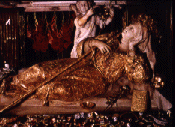 Santa Rosalia's shrine, Palermo Santa Rosalia's shrine, Palermo
Year 1: The Insects
An introduction to the evolution, diversity and key innovations of the insects,
in five lectures. We consider the evolution and innovations of the main taxa, and then
study three topics in detail: the evolution of flight, the compound eye and holometaboly.
Year 2: Experimental Design & Analysis
This 2nd-year course aims
to teach students how to develop the faculty of asking scientific
biological questions, by using a hands-on approach. Using animal
behaviour as a vehicle for this, students first of all spend
time watching their animals and thinking about possible questions.
From there, we develop ways of answering their questions, introducing
the ideas of experimental design, summarising data, and tests
for difference or trend questions. We use relatively underused
non-parametric methods because they allow specific hypotheses
(testing for a particular pattern of mean values, for
example) and also the more usual general hypotheses (testing
for any differences between means, for example). We
published a book that encapsulates our approach, now in its
4th edition that uses the freeware statistical program R and
self-written Excel-based software
(Barnard, Gilbert & McGregor, 2011:
Asking questions in Biology. Pearson). Chris Barnard finished
the 3rd edition just before his untimely death in June 2007 at the age of 55.
The Excel-based sheets are available [here]
to do all the tests that we describe.
Year 2: Ecology
A 2nd-year module of 11 four-hour sessions, taught with my colleague Tom Reader;
this is a detailed look at modern ecological ideas from an evolutionary
perspective, structured so that it discusses individuals, then populations,
and finally communities. The course considers resources, life histories,
phylogenies, individuals in populations, species interactions, food webs,
biodiversity, and the implications of all of these ideas for understanding
human biology.
Year 2: Behavioural Ecology field course in Portugal
We have been running this 2nd year two-week field course in Portugal since 1986. It is research-based:
students are in small groups of four, and work on a single project that
addresses questions relevant to our own research interests.
We have published many papers from these projects. For example:
Behnke JM, et al (1993) The prevalence
and intensity of infection with helminth parasites in Mus spretus
from the Setubal peninsula in Portugal. Journal of Helminthology 67: 115-122
[PDF]
Duffield G, et al (1993) Choice of flowers by foraging honeybees (Apis mellifera L.):
possible morphological cues. Ecological Entomology 18: 191-7
[PDF]
Gonzalez A, et al (1995) Flower choice by honeybees (Apis mellifera L.):
sex-phase of flowers and preferences among nectar and pollen foragers. Oecologia, 101: 258-264
[PDF]
Behnke JM, et al (1995) Identity, prevalence and intensity of infestation with wing feather mites on birds
(Passeriformes) from the Setubal Peninsula of Portugal. Experimental & Applied Acarology 19: 443-458
[PDF]
Gilbert F, et al (2001) Individual scent marks made on flowers by a solitary bee.
Animal Behaviour, 61: 217-229
[PDF]
Reader T, et al (2006) The effects of predation risk from crab spiders on bee foraging behavior.
Behavioral Ecology 17: 933-939.
[PDF]
Year 3: Evolution & Behaviour
This 3rd-year module eschews the traditional lecture/practical format, and instead is based upon self-directed
investigations and problem-solving exercises. At this level we find it an excellent
way to convey the detail and the excitement of the topic. The course consists of an
introduction on day 1, a set of topic investigations, and a set of problem
sessions. Topic investigations happen in 2-week blocks. At the
beginning students are given a series of questions to answer in relation to
the topic, and some references to start researching the answers. Answers are
handed in at the beginning of the last afternoon of the topic session: the
rest of the afternoon is a general discussion of the findings and ideas.
Problem sessions occur periodically through the course,
with invited speakers outlining different problems in evolution and behaviour,
and asking for suggested explanations or solutions. The
exercise involves the speaker outlining some basic background to a system,
and then presenting a problem (some data, or some observations, or a suggestion)
that needs explaining. Working in small groups, students think of as many
explanatory hypotheses as possible, and these are then presented to the
speaker for listing and eventual assessment. General discussion will then
be followed by the presenter suggesting his/her own interpretation, and
indicating the general points that the exercise has brought to light. Usually
the speaker then homes in on a single hypothesis, and there is another round
of group brain-storming for possible tests of this hypothesis.
Year 3: Conservation
This 3rd-year module arose out of my experience in running BioMAP in Cairo during
2004-7. It studies conservation philosophy, theory and practice in some detail, trying to use Egyptian
and UK examples throughout, with contributions from practising conservationists in the public
and private sectors. It has a strong practical component, including
IUCN Red Listing and modern approaches to monitoring, and practical exercises
on species distribution modelling using the software program MaxEnt, density estimation
using Distance sampling, and Population Viability Analysis using Vortex.
Year 4: Science & Society
This 4th-yr (MSci) module outlines the philosophy and practice of science, considering
the history and philosophy of science, the norms and sociology of science, peer review
and the scientific literature, funding and assessment of scientists, ethics and fraud in science,
and the role of government and the media.
Year 4: Advanced statistical methods
This 4th-yr (MSci) module outlines modern statistical analysis. My role is to survey multivariate
methods, to underline how useful they can be in many different research contexts.
|
 Santa Rosalia's shrine, Palermo
Santa Rosalia's shrine, Palermo